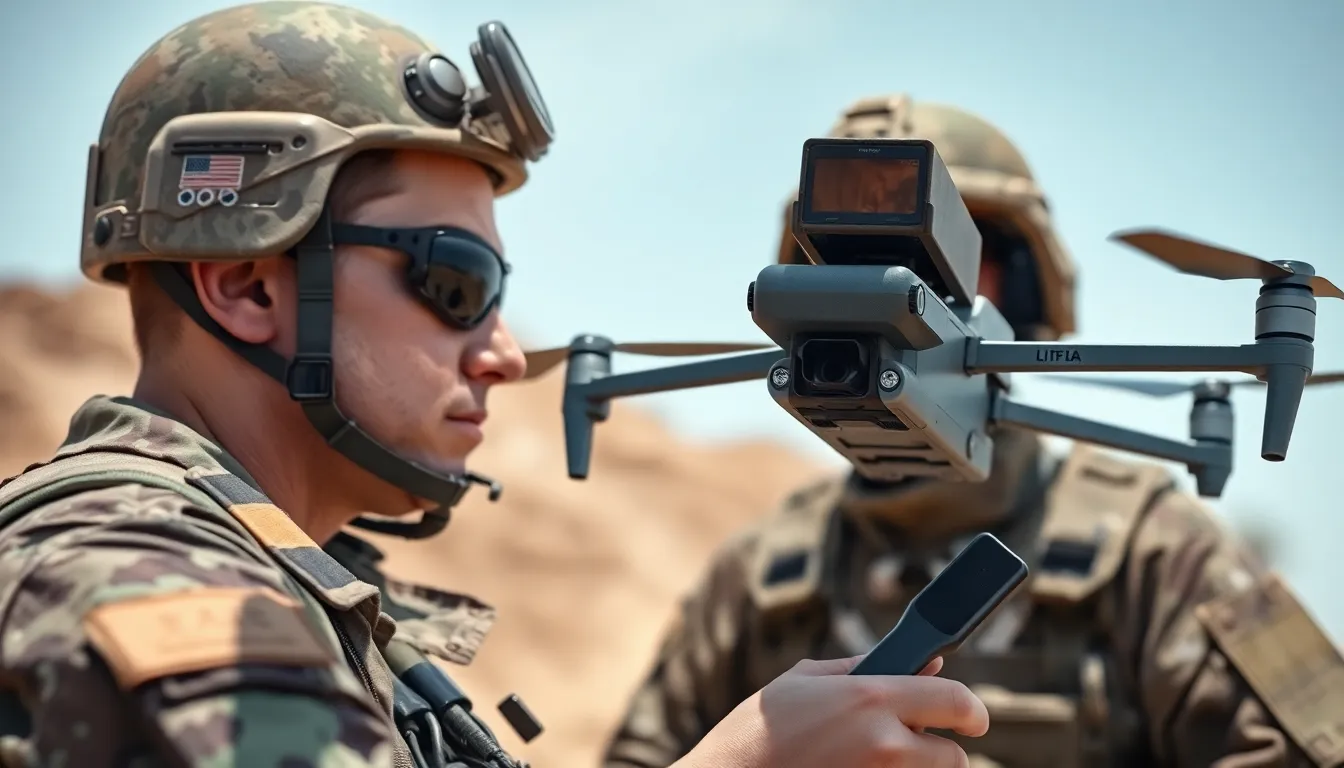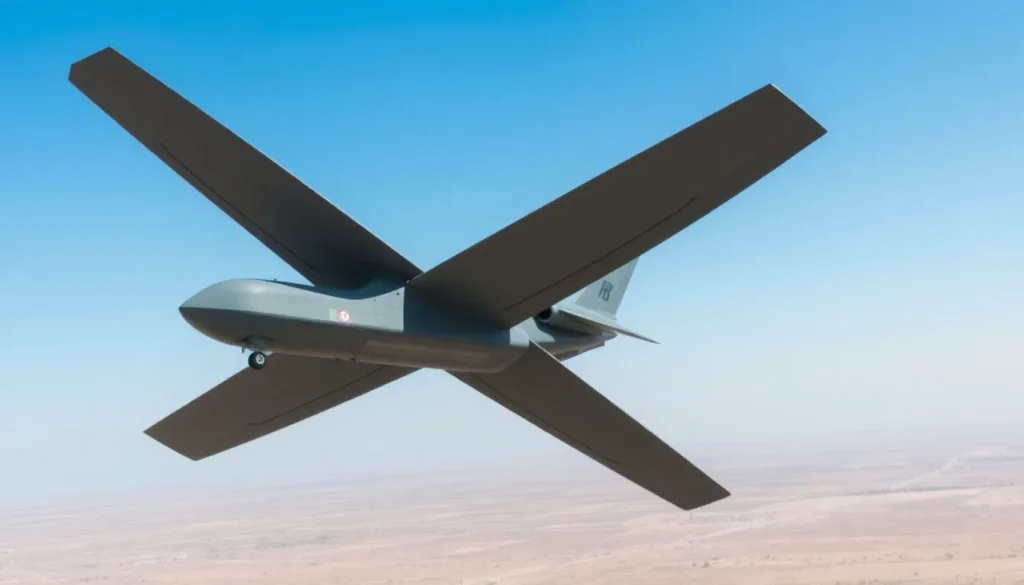When it comes to military drones, size really does matter. These high-tech flying machines come in all shapes and sizes, from the compact models that could fit in your backyard to the massive behemoths that could easily double as a small airplane. It’s a world where “bigger is better” takes on a whole new meaning, and the stakes are sky-high—literally!
Table of Contents
ToggleOverview of Military Drones
Military drones vary significantly in size and purpose. Small drones, often known as tactical drones, usually measure less than 5 feet in wingspan and weigh around 10 to 50 pounds. These models excel in reconnaissance and surveillance missions, providing real-time data to ground forces.
Medium-sized drones commonly range from 5 to 15 feet in wingspan. Weighing between 100 to 1,200 pounds, they serve multiple roles such as target acquisition and intelligence gathering. Popular models like the RQ-7 Shadow showcase capabilities that extend from surveillance to close air support.
Large drones, also referred to as unmanned aerial vehicles (UAVs), boast wingspans that can exceed 40 feet. These aircraft, like the MQ-9 Reaper, typically weigh over 10,000 pounds and engage in armed reconnaissance missions. The advantages of larger drones include enhanced payload capacity and longer flight durations, providing strategic benefits on the battlefield.
The scope of military drones also encompasses transcontinental models. These high-altitude, long-endurance drones often span over 60 feet. Their considerable build allows for extended surveillance operations, affecting strategic military planning and deployment.
Size directly influences the operational capability of a drone. Larger UAVs can carry advanced sensors and weaponry, effectively increasing their combat and reconnaissance proficiency. Compact drones, while limited in payload, can infiltrate difficult terrains, delivering intelligence without detection.
Military drones present a diverse range in size, with each model designed to meet specific mission requirements. Their varying dimensions play a crucial role in determining capabilities, applications, and overall effectiveness in military operations.
Size Categories of Military Drones

Military drones fall into distinct size categories, each serving different operational purposes. Understanding these categories enhances the comprehension of their capabilities.
Small Military Drones
Small military drones measure less than 5 feet in wingspan and typically weigh between 10 and 50 pounds. They excel in roles such as reconnaissance and surveillance, providing real-time intelligence. Common models, like the Raven or the Wasp, offer mobility in confined spaces, making them ideal for tactical operations. These drones often feature advanced sensors and can transmit live video feeds, enhancing situational awareness for ground troops.
Medium-Sized Military Drones
Medium-sized military drones range from 5 to 15 feet in wingspan and weigh between 100 and 1,200 pounds. Performing multiple functions, they support target acquisition and intelligence gathering, with models like the RQ-7 Shadow as prime examples. Enhanced payload capacity allows these drones to carry various sensors and equipment. Their versatility makes them suitable for a multitude of missions, ensuring they can adapt to evolving combat environments.
Large Military Drones
Large military drones, often referred to as unmanned aerial vehicles (UAVs), can exceed 40 feet in wingspan and typically weigh over 10,000 pounds. Engaging in armed reconnaissance, models like the MQ-9 Reaper showcase the advantages of their size. These drones are capable of carrying advanced weaponry and sophisticated sensors, which provide significant strategic benefits in combat. Long flight durations and high payload capacities enhance their operational effectiveness, making them integral to modern military missions.
Factors Influencing the Size of Military Drones
Several factors determine the size of military drones, each influencing their operational capabilities. Understanding these factors enhances insight into their effectiveness on varying missions.
Mission Requirements
Mission requirements play a crucial role in shaping the dimensions of military drones. Specific tasks dictate whether a drone needs to be small for reconnaissance or large for surveillance and attack missions. Tactical drones, under five feet, provide essential intelligence in tight spaces. Medium-sized drones, between five to 15 feet, can adapt to more complex operations, such as target acquisition or electronic warfare. Larger drones excel in armed reconnaissance, allowing for extended flight times and payload capacity. Each mission type prioritizes distinct features, thus influencing the size selection.
Design Specifications
Design specifications significantly impact a military drone’s size. Aerodynamics dictates certain dimensions to ensure optimal performance, including speed and stability. The need for advanced sensors and equipment also drives size decisions. Larger drones must accommodate substantial payloads, integrating technologies that enhance data collection and combat effectiveness. Moreover, structural integrity plays a role in determining dimensions, ensuring drones withstand harsh operational environments. Each design element correlates with mission objectives, underscoring the importance of size in drone capabilities.
Comparisons with Civilian Drones
Military drones differ significantly in size compared to civilian drones. Small military drones can measure less than 5 feet in wingspan, while civilian counterparts often range from 2 to 6 feet. The weight of military drones, starting at 10 pounds, contrasts with civilian models typically weighing up to 5 pounds.
Medium-sized military drones fall into the 5 to 15 feet category, while civilian drones often remain under 10 feet. Military examples include the RQ-7 Shadow, which supports complex missions through improved payload capacity. Civilian drones emphasize lightweight designs focused on recreational use, lacking versatility in mission roles.
Large military drones exceed 40 feet in wingspan and can weigh over 10,000 pounds. In contrast, civilian counterparts are usually restrained to a maximum of 10 feet and generally under 50 pounds. The MQ-9 Reaper showcases military size advantages by facilitating armed reconnaissance missions that civilian drones cannot perform.
Mission requirements greatly influence the selection process of drone sizes. Larger military drones accommodate advanced sensors and weaponry, improving operational effectiveness during critical missions. Civilian drones prioritize user-friendliness and portability, primarily for leisure or less critical tasks.
Technological differences also impact design specifications. Military drones utilize advanced materials for durability and performance, while civilian models tend to favor budget-friendly materials. These design choices result from unique operational capabilities unique to military needs.
Overall, the contrasts in size, purpose, and design between military and civilian drones highlight the critical role each type plays in their respective domains. Understanding these differences provides a clearer view of the evolving landscape of drone technology.
Future Trends in Military Drone Sizes
Emerging trends indicate that military drone sizes will continue to evolve in response to operational needs. Larger drones are expected to become increasingly important due to their enhanced capabilities, such as longer flight durations and greater payload capacities. Advanced technology may enable smaller drones to perform more complex missions, effectively narrowing the gap between size categories.
Adaptability is crucial. As battlefield environments change, military drones must adjust their designs accordingly. Innovations in materials and engineering techniques will likely contribute to this adaptability, leading to lighter structures without compromising performance.
Increasing automation and AI integration may allow for greater micro-drone usage. Capable of sophisticated tasks, these small drones can gather intelligence in tight urban settings or hostile areas. Their diminutive size facilitates stealth operations, providing militaries with valuable reconnaissance advantages.
Collaborative drones are another trend to watch. Multiple small drones working together may offer synergistic capabilities for reconnaissance and situational awareness. This shift towards swarm technology can redefine how military operations are conducted.
The role of payload and mission specifications will remain vital in determining the size of future military drones. Different operational requirements dictate diverse design needs, including speed, maneuverability, or payload capacity. Manufacturers will adapt to these needs to optimize drone performance.
International developments in defense capabilities will likely influence military drone sizes across different nations. Diverse strategic priorities could lead to the emergence of new drone classes that align with regional military objectives.
Lastly, advancements in stealth technology may push the boundaries of large drone design. As nations strive for greater aerial dominance, enhanced stealth capabilities can lead to larger drones that remain undetected while executing critical missions. The future of military drones promises a fascinating landscape of innovation, driven by the demands of modern warfare.
The size of military drones plays a pivotal role in their operational effectiveness. From small tactical models to large UAVs, each size category offers unique advantages tailored to specific missions. As technology advances and battlefield dynamics evolve, the future of military drones will likely see a shift toward larger models with enhanced capabilities, while smaller drones will become increasingly sophisticated.
Understanding the implications of size in military applications is essential for grasping the complexities of modern warfare. As innovations continue to emerge, the landscape of drone technology will adapt, ensuring that military forces remain equipped for the challenges ahead.

